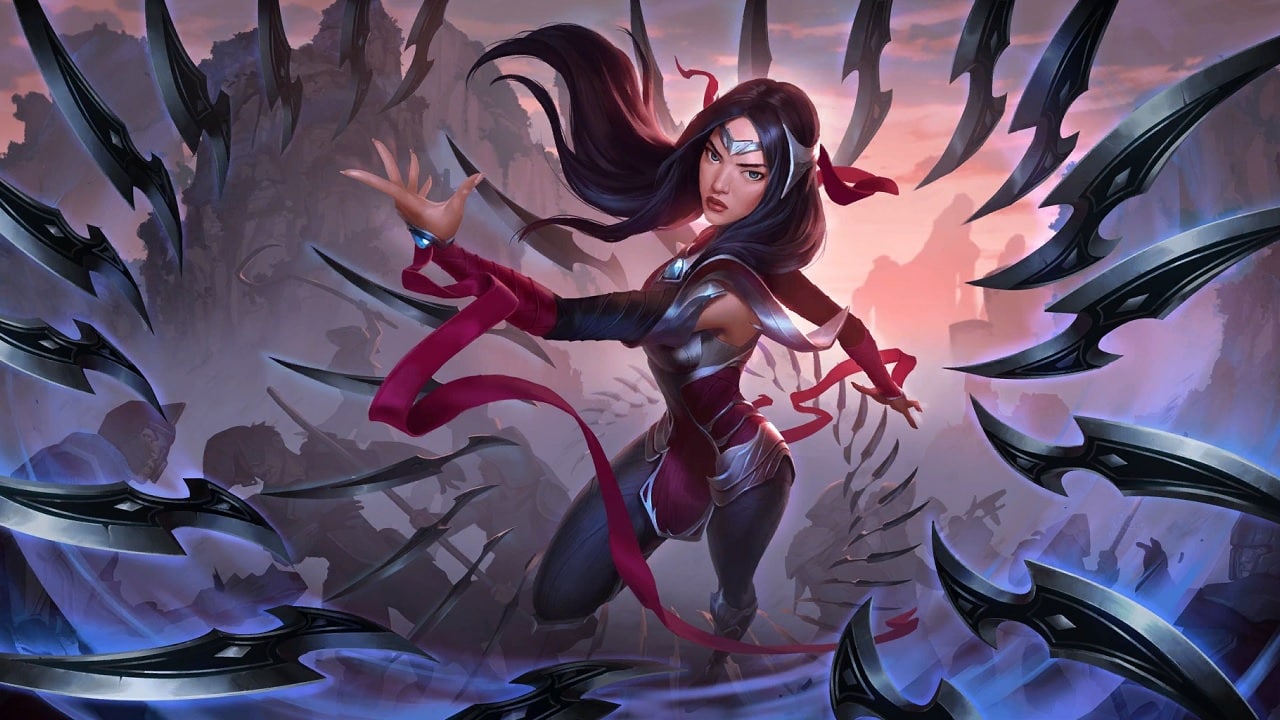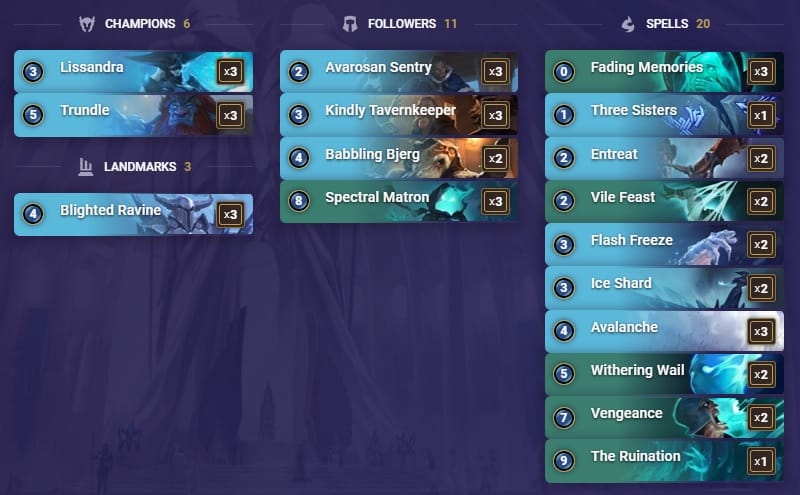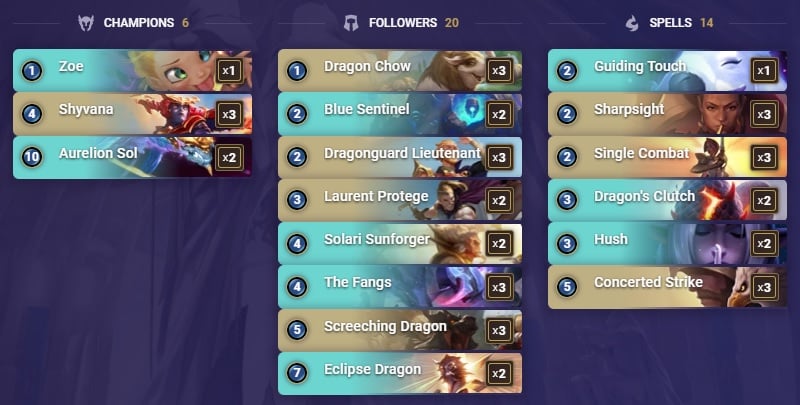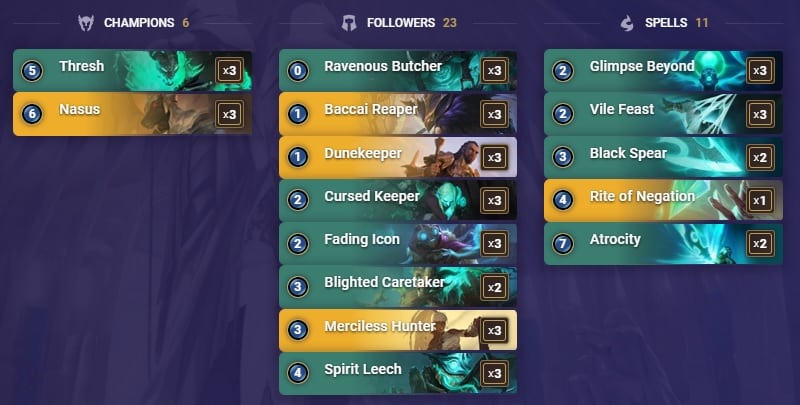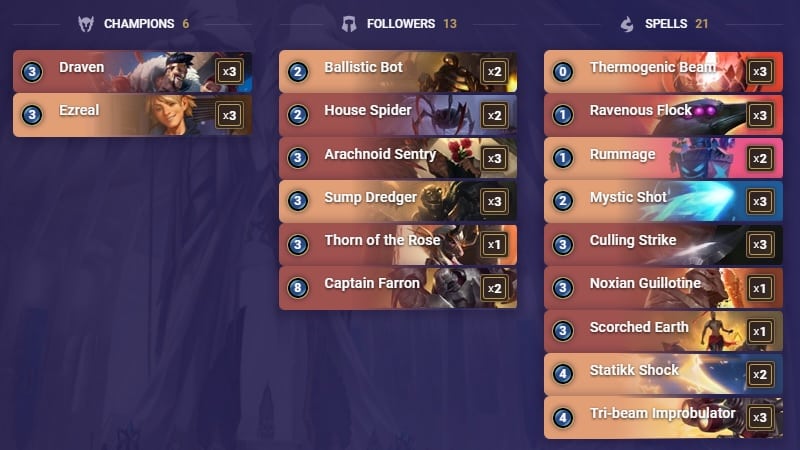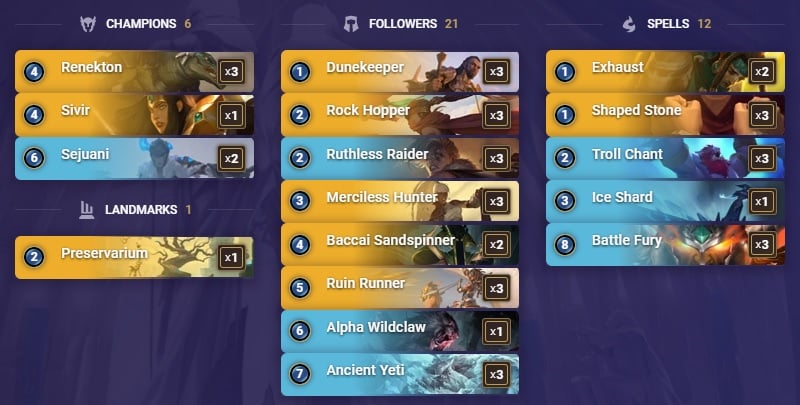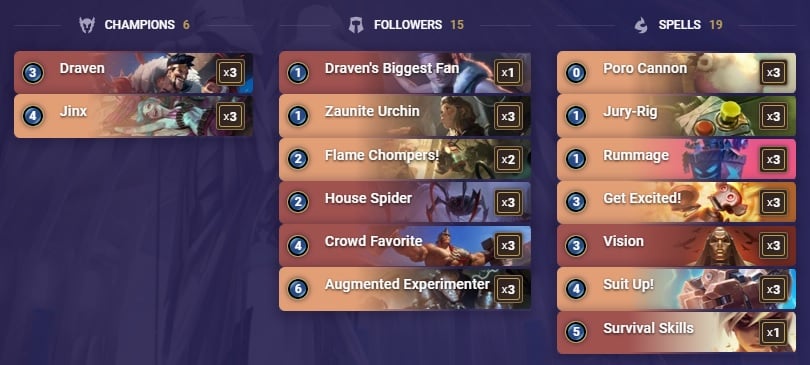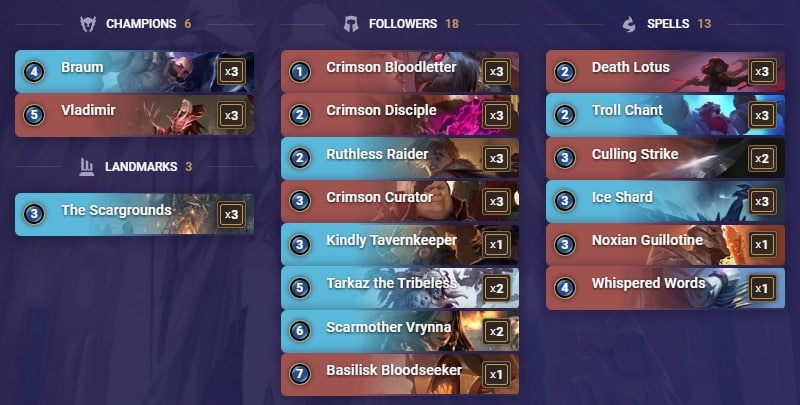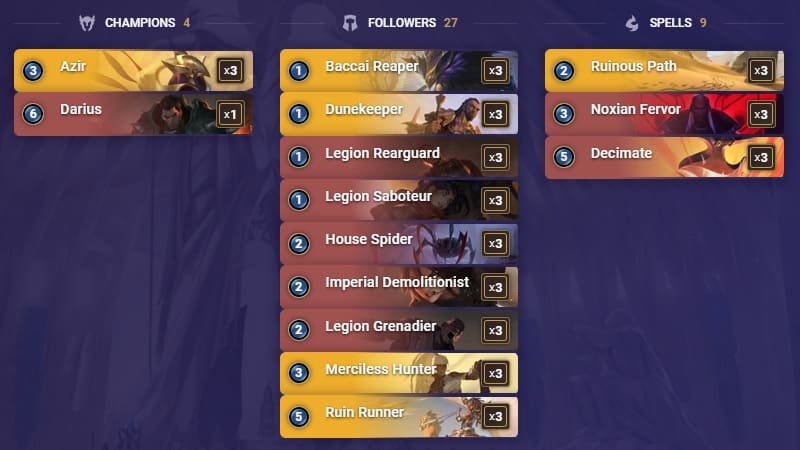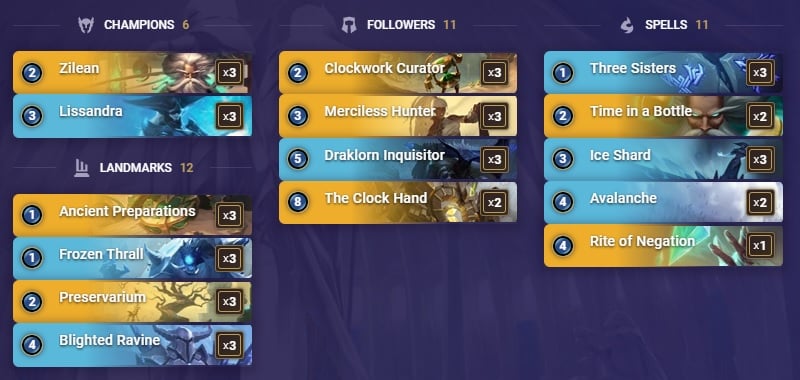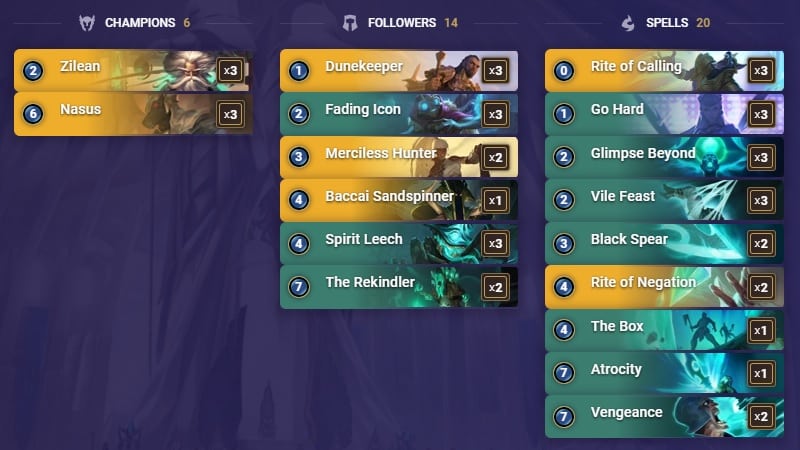Welcome to TLG’s latest meta snapshot for Legends of Runeterra, a series in which we give you our insight on the finest decks in the higher ranks of the ladder.
Every Monday, we discuss the decks that are part of the week’s meta and rate them on a scale of 1 to 5 stars. We also look at the evolution of said decks’ ratings across weeks and draw conclusions regarding the current state of the game, all of this so you can delve into your own ranked journey with a head start.
Despite Irelia-Azir’s popularity, not much has changed this week. TLC, Dragons and Thresh-Nasus are still good choices for climbing the ladder and Ezreal-Draven remains a strong post-expansion punisher. Renekton’s new ally, Merciless Hunter, has pushed the Overwhelm archetype up the rankings a bit.
Perhaps in the coming weeks, we will see a meta stabilization and the emergence of some other contenders, but for now the old favorites still have it. Othal has a spotlight explaining why this was true for the latest Fight Night tournaments, too.
If you have any questions, feel free to drop by our Discord. Best of luck on your climb!
Graphics: WellMax81
Editing: Wusubi, Sebodunum
Writers: Den, Ultraman, Othal

CECAEAIFFQXQGAIBAMKDEAQEAECQ4AIDAEDAGAYBAEAQOHIDAECQCHJIAECACCICAECACCQBAECQ6
Difficulty: Moderate
Most of the new decks that came out for now are aggressive builds that Trundle-Lissandra (TLC) can easily contain. Looking at our snapshot this week, there aren’t many decks TLC is afraid to face other than Overwhelm or Dragons, which justifies its top spot in the first week of this new meta.
The deck doesn’t include new cards, and this list was used by Pespscola to win the latest EU Fight Night tournament. It doesn’t feel like anything new is needed for this deck to perform. The Freljord wide punish package prevents almost every swarm deck from development in the first 4 or 5 turns and Vengeance or the single copy of The Ruination is great help in the later stages of the game against Midrange builds.
TLC still packs a lot of draw and can speedrun its combo against other slow decks, and Deep is rare on ladder at the moment anyway. In essence, TLC doesn’t fear most control-oriented matchups when it comes to reaching its win condition first.
The showcased list has enough card draw to be able to play Spectral Matron on Turn 8 every game, which makes it a great pick for ladder or tournament play, as the high-roll potential is matched with great stability. (Write-up by den)
CICQCAIADIAQEAABAEBQTXIBAECAADQEAMAAMCALBYBQCAIABMAQICIEAUBQSAZZKVLWIAICAMEQSMY
Difficulty: Easy
As strange as it may sound, Shyvana is now the optimal option for Demacian-based Targon decks, as she heavily counters Irelia. The Fury keyword is brilliant against decks like Irelia-Azir, as the attacking tokens keep triggering the keyword and fueling the Dragons’ stats to the point of no return. Obviously, Lifesteal minions are important against aggressive and swarm-based decks, and it helps that they can sometimes take several trades or deal multiple blows thanks to Concerted Strike or Single Combat.
Blue Sentinel on Turn 2 is a nightmare for Aggro decks, as its Last Breath effect means that if they attack and kill it, you can get a Shyvana on Turn 3. Given her ability to both attack and defend efficiently, they’ll have a rough time dealing with her. As for the late game, Eclipse Dragon combined with ASol makes for a powerful tempo play. If you’ve already taken over the board, this will usually mean ASol levels-up as well. As ever, this should result in you closing out the game quickly.
Thanks to Hush, Dragons gain another good matchup into Thresh-Nasus, which is obviously great for ladder play. Aim to resist the early pressure with combat tricks, then take the board back with Screeching Dragon and Shyvana before ending the game with a Hush to answer Nasus or Atrocity. (Write-up by Ultraman)
CMBQEBAFAMIAIBAHAINC6ZYFAECQWKBQGE2AEAICAUCAEAIFDERACAIEA45Q
Difficulty: Easy
Thresh-Nasus remains one of the best archetypes as of now, despite the nerfs to Atrocity and Blighted Caretaker. The addition of Merciless Hunter helps dealing with threats earlier (e.g. Ezreal) and allows you to make value trades, as her presence usually requires two cards from your opponent to be handled.
The early tempo of Ravenous Butcher, Cursed Keeper, Blighted Caretaker and Dunekeeper is still unmatched, granting you a great opener with which you can transition into Thresh. If your opponent failed to answer the early pressure every turn, they’ll have to kill both your minions and Thresh. This will force them into poor choices, proactive plays and suboptimal removals that you’ll be able to punish with Glimpse Beyond, Black Spear, Vile Feast or Rite of Negation.
And even if the opponent manages to withstand the early storm, they’ll still have to deal with Nasus. Depending on the deck you’re facing, Nasus can prove an insurmountable threat or a juicy Hush target. Either way, though, his pressure is undeniable and Atrocity will still obliterate the opposing Nexus, even if it costs one more mana now.
Ezreal-Draven especially struggles to answer Nasus - the deck can’t destroy him immediately, so he should be able to level-up and get Spellshield. Once this happens, you can kill them by responding to any spells thrown at you with Atrocity.
Thresh-Nasus also does quite well into Irelia builds, mainly by having access to a lot of early tempo, pressuring them while also taking advantage of the swarming Blade tokens playing directly into the hands of your champions. (Write-up by Ultraman)

CECACAQDBEAQGBARAMAQGBAUFYCACBA3EQTDIAYBAMCAKAQBAMZTOAQBAQAR6AYBAEBRMAIDAMGQCBADBI
Difficulty: Easy
As each and every season, Ezreal-Draven shines as the anti-fun archetype, wheeled out by players wanting to stamp out those experimenting with new or unoptimized lists. Like a tough old veteran warming up the new trainees, this deck won’t take any of your bullshit. It’s strong and stable, with the ability to remove many threats and switch to more control or aggression-based gameplay depending on the deck it’s facing.
Matchup-wise, the ol’ man struggles against quite a few of the more-established decks, including TLC and Thresh-Nasus, but it compensates for this by utterly destroying any deck that tries to win through board pressure. Watch as the Demacians fall, one after the other, while Freljord Midrange suffers a similar fate.
Against your bad matchups, Ezreal will be your best bet, as he can take advantage of even the smallest window of opportunity once flipped to deal significant Nexus damage. If the opponent ignores him and tries to go for any combo play, you can punish them and take the game with the right tools in hand. (Write-up by Ultraman)
CMCAEAICFIWAEAQCAUFAGBAHAMNDGBIEAICAKCILB4AQCAYCAUBACAYCCQAQIBZZ
Difficulty: Easy
Irelia is the new girl in town, and she’s unleashed quite the storm upon arriving in the game! Associated with Azir, she benefits from the swarm abilities of our favorite birdman, combined with Emperor’s Dais. With an absurd number of attacks available to you thanks to Blade Dance, you’ll level-up both of your champions extremely quickly.
It will get eye-watering for the opponent once Azir is flipped and the Blades and Sand Soldiers start attacking them multiple times per turn with raised attack stats and the potential for shady switching thanks to Irelia. Deal with blockers little by little and make sure your win conditions stay alive with multiple copies of Retreat, Lead and Follow and Nopeify! to stop the pesky removals from bothering your sand army.
The Recalls can also be used on Blade Dance units, creating even more attack opportunities. These waves and waves of attacks will make it difficult for any opponent to emerge unscathed. Stun your biggest counters with Concussive Palm (e.g. Renekton, Shyvana, Lifesteal minions) in order to stop them from destroying you in the later stages of the game.
Your win conditions are fragile, and your whole game plan will be to play them carefully enough to keep them alive, as every single wasted removal from your opponent will open more avenues for you to win the game. (Write-up by Ultraman)
CMCACAQBAYAQGAICAIAQCBI7AYCAOGRGG5BV2ZYCAEBACAQCAQDS2UIDAEAQCGQBAQAQSAQEA4GRI
Difficulty: Easy
A deck that was a bit on and off last month is having a great start in May. With the addition of Merciless Hunter, Renekton has found one more ally to join his cause. Having an effective 3-drop gives the deck a much better curve and helps the Overwhelm mechanic pick its battles more effectively, which of course directly translates into achieving more Nexus damage over time and better trades in the Midrange matchups.
With average to good matchups against the current juggernauts (TLC, Thresh-Nasus, Ezreal-Draven) the deck looks like it could be a solid pick across the board, and several players have trusted it to climb the ladder or even to bring it to the latest edition of the Fight Night tournament (like Agigas or Saltysimon).
The list presented here is actually a mix of both these players’ decks, as Dunekeeper feels great instead of Omen Hawk (better blocking ability and 2 targets instead of 1 for a Battle Fury in the late game) and Ice Shard helps against all of the Aggro decks (Irelia, Discard Aggro, Shurima Burn) but can also help pushing more damage later on, weakening the opponent’s defenses to get more Overwhelm damage during an attack.
Lastly, in addition to Merciless Hunter, Baccai Sandspinner has also found its way back into the list, as the current meta features a lot of chump blockers that we can abuse once they’re given the Vulnerable status. This allows us to level Renekton or simply deal a ton of damage through a 1-health blocker.
If you’re looking to pick up this deck, I would recommend working on timing your attacks. It’s easy to go for big damage turns, but that can be at the sacrifice of the defensive part of the game, which is also very important to consider in order to ensure that you’re the one applying the pressure.
This will help you avoid entering into a damage race which isn’t so easy to win considering we have no healing and no direct damage from hand. Having good timing on when to start looking to push damage will allow you to keep your own allies and Nexus healthy, making a lot of decisions much easier down the line. (Write-up by den)
CECACAQEAMAQGBASAQAQGCIUE43QMAIEAEGRYJZIFUAQCAIEBQBACAIDEMAQGAYP
Difficulty: Moderate
Another patch, another day at the office for Discard Aggro. Thus far, the deck doesn’t look like the mean machine it has been in the past, but it’s still holding a good position in our ranking when it comes to its ability to climb the ladder. With very balanced matchups in the meta, Discard Aggro doesn’t really have a good reason to be played.
For now, Ezreal-Draven seems to be the better deck with the Noxus-PnZ pairing. It’s also true that Discard Aggro doesn’t have horrible matchups across the board either, and players looking for a comfort pick could find it to be the perfect archetype, as the deck is stable in what it does each and every game and packs enough pressure to outpace almost any deck.
With Irelia joining the battle, Ionia has become a more popular region, which is good news for Draven and Jinx, as Quick Attack is a nightmare to defend for the region. Since Ioania is incapable of removing her, Jinx can single-handedly win you the game from the back row if flipped early.
With Thresh-Nasus, TLC and Dragons looking like the early best trio, Discard Aggro doesn’t have great matchups to feed on, but it still looks like a better option than Shurima Burn, a deck that feels much more volatile in its gameplay. The never-ending draw power and constant pressure, mixed with Draven and Jinx’s capacity to be threatening in different ways, gives you the flexibility other Aggro decks don’t have at the moment.
For now, despite once again looking like the best damage archetype, Discard Aggro might look a bit lackluster compared to the new and shiny Irelia decks. However, time will tell us which aggressive mechanics will come out on top. (Write-up by den)
CIBAEAQCAMDAOAYJBENSGKBJGNOAIAIBAIYQCAYCCQAQIAQHAIBAEBIJAIAQEAQIAIBQSE2V
Difficulty: Hard
One more meta, one more Lee Sin deck to take into ladder and tournament play. The blind monk doesn’t look like he will slow down anytime soon, even though the deck cannot be compared to our Top 3 anymore, as it lacks in the defensive department against aggressive openings. Despite this, the deck remains a very decent overall pick.
Although only one new card has found its way into the build, Syncopation provides some nice surprises to our opponent. It can serve as a defensive card to get our most important unit out of a spell or a trade, as a damage push later in the game, or simply to force the opponent into trading one of our 2/1 Lifesteal units.
The big strength of the deck is its ability to adapt to the different matchups on the ladder, which can also be a weakness if our meta read was off. For now, Lee should be geared towards beating Ezreal-Draven while getting some help against Overwhelm and Aggro decks. This isn’t an environment that benefits the deck, which explains why you might not see it too much.
In tournaments however, the deck still performs well, as it was part of Pespscola’s winning line-up in the latest EU Fight Night. As the meta keeps on developing, we should gain more clarity on what the best decks are, which makes it easier to tech for the crucial matchups. (Write-up by den)
CEDACAIBBEAQEAIGAECACCIBAQBREAQDAEBBIBABAMDB4MBSAIAQCAYEAIAQCDIVAQAQCAJSAEAQGFQBAMBRCAIEAMBA
Difficulty: Hard
Have you ever heard of a deck which isn’t very good, but it has that one matchup where it feels impossible to lose? Well, when that easy matchup is against Irelia, it feels great to play such a deck. This week, that distinction goes to Braum-Vladimir.
Don’t get too excited, the deck isn’t a top tier contender or anything close to that, but if your goal is to deal with a flurry of small minions, then this is the deck you need. It should be seen as a counter-pick and not an overall good deck for laddering. Its linear gameplay and its need to find mechanics that it’s strong against limit it too much for it to shine on the grand stage.
I would personally recommend the deck if you’re in Platinum or lower, as the board control the deck offers plus Vladimir being tough to remove for a lot of decks and providing precious Nexus drain are two solid foundations for winning games. What the deck lacks to reach the higher tiers is some flexibility, as its removal package is limited to small units most of the time and the relative lack of draw is still a problem for the deck.
This list includes a copy of Whispered Words, which feels necessary even though it will have to be played at its full 4 mana cost in a lot of situations. Braum-Vladimir’s evolution will be based on how the meta progresses in the coming weeks, and the deck could either disappear or become the hottest pick available depending on what other decks will be popular. (Write-up by den)
CEBQGAQGCY3TYBIEAICAKCILB4CACAQGFIWDSAQBAMBBIAIBAIYQA
Difficulty: Hard
For now, it seems like Azir got the nod over Miss Fortune as the best pairing with Irelia, since the high-roll potential looks much greater. That doesn’t mean the pirates are to be dismissed, though, as they can deal much more damage in the early game and pressure the opponent in a different way.
Just like its Shuriman counterpart, this deck relies a lot on being able to protect its key units (i.e. both champions) in order to create a never-ending flow of pressure. The main aspect of this is in deciding when to start going all-in with the pressure and when can we take time to build our offense with Jagged Taskmaster’s Plunder ability, for example.
Understanding the timing of the deck is important considering how much damage we’re capable of shipping to the opposing Nexus once we get rolling. An early aggressive push can fall short, as we wouldn’t be able to sustain it long enough to kill our opponent, while a late start could see a big opposing board that would destroy our chances of getting through.
Most of the time, this deck should be seen as a tempo deck that tries to snowball Miss Fortune and Irelia’s passive, but in some occasional setups, holding our resources a bit and trying to go for a huge turn where MF would level almost instantly is a valid game plan that can catch the opponent unprepared.
With the meta still forming and Irelia probably being the champion with the most lists around currently, there is no doubt this deck and the Azir-based archetype will keep on changing some cards and their power level should vary as well. For now, we can see that the deck is experiencing good results on ladder, but don’t consider it a finished product and have an open mind about the results you could have with it. (Write-up by den)
CMBQEAQDAMCAKAIDAIGCKKBXAYCAOAQDDI3VEZYAAEAQCAZG
Difficulty: Easy
What if I told you Burn decks are good in the earliest stage of a new meta? Surprising, right? The rush to Masters increases the playrate of such archetypes, as everybody is more focused on how fast they can climb rather than caring about their winrate.
Quick games is mainly what this deck has to offer, but it also has some redeeming qualities. The Overwhelm Midgame fits in with Shurima’s early game, making for more resilient minions after you damaged the opposing Nexus a bit.
Fight for the board as long as possible, but don’t sacrifice Nexus damage for board control, except if your opponent already has access to a lot of healing in their deck. Most of the time against other decks such as Ezreal-Draven, it’s better to go all-in on the damage and hope for good top-decks later on, or that they’ll miss their answers to Darius or Ruin Runner.
If you start engaging in trades, you’ll just die slowly as your opponent outvalues you. Mostly efficient against poorly-built decks, Shurima Burn punishes the early expansion greed in the best possible way: quickly, so you can climb rapidly. Once in Masters though, it’s best to shelve the deck and switch to something more flexible. (Write-up by Ultraman)

CMBAKBAHBUOCOLDHAYCACAIFAYEQUDQCAEAQCFACAQDSEQQBAECAOOY
Difficulty: Moderate
Surprising to say the least, a Landmark archetype is finally viable. While Taliyah still searches for a deck that would accept her, Lissandra takes it upon herself to provide this deck with a win condition, set-up, trades and some early game. She can do it all, and trust me, she will!
She’s not helped much by Zilean, though, as he’s mostly there to contain aggression and be a removal target. That said, your opponent usually won’t be able to avoid answering his potential threat, because a flipped Zilean is a force to be reckoned with. Time Bomb, Avalanche and Blighted Ravine handle aggressive boards, while the Thralls slowly emerge from their icy tombs.
Their emergence can be accelerated thanks to Zilean’s spells, granting you an earlier access to multiple 8/8 Overwhelm units. Draklorn Inquisitor also will also help with this, freeing the Thralls from their deep slumber faster than expected.
Force your opponent into carefully answering each threat, until they either have no pressure left to stop you before Lissandra levels-up, or they misses a removal and you get to have a board full of gigantic minions. (Write-up by Ultraman)
CMCACAYFCABACBJIGEBAIBIDCACAIBY2E4XXSAQCAQDTWZYDAECQCFBCAIAQIB2RAIAQKEYZ
Difficulty: Easy
While the synergy between Go Hard and Zilean might seem a bit counter-intuitive, they both benefit from having a lot of card draw in the deck. The likes of Glimpse Beyond and Spirit Leech both help you course through Go Hard and Time Bombs as fast as possible in order to level-up Zilean. A flipped Zilean will be amazing, giving you more copies of Go Hard and Pack your Bags, allowing you to destroy the opponent’s board every turn.
The problem with this is that it takes a significant amount of time to level your Zilean. As such, you’ll often find the deck lacks consistency, or just ways of ending the game quickly. You’re able to handle aggression well, but usually end up losing ground against Midrange decks. Nasus is your savior in these matchups, allowing you to trade blows with enemies and force removals. Yet, even the almighty doggo will fall to Hush, Vengeance or Noxian Guillotine.
In order to stop these removals, you’re equipped with Rite of Negation, and a good, reliable Atrocity to steal a game there and then. In the full knowledge that Zilean and Nasus would make prime removal targets in the deck, The Rekindler comes in to bring them back to life.
The main problem is the lack of tempo, and as such, you’ll sometimes already be in a bad spot before Nasus or The Rekindler can come in and help you deal with the opposing board. Pack your Bags is your only hope in such situations, but it can prove difficult to rely on and set-up consistently. (Write-up by Ultraman)

With a new expansion just in and Ionia decks everywhere on the ladder, we were all curious as to what the tournament meta would look like. Would players stay on the safe side and bring the likes of TLC and Thresh-Nasus, or would new decks perform and threaten to seize the throne? Fight Night seemed to be a perfect way to find out, with 16 players across 2 shards.
Among 32 decks, diversity was the name of the game - 18 different archetypes were represented, and among them were the usual Thresh-Nasus or TLC, but also the newer Irelia-Azir or some spicy Demacia/SI brew and Zoe-Vi.
European players decided to stay on the safe side, with the only new archetypes there being Zilean-Nasus and Soraka-Braum brought by Trishfangirl69. This gamble didn’t pay off, as Trishfangirl got eliminated in the second round of the losers bracket. Americas brought in some spice but were still relatively safe, with only 3 new archetypes across 16 decks.
While Irelia-Azir performed well, the other new archetypes proved they were no match for the older ones. (Write-up by Othal)
Fight Night EU
European players decided to play the tried and tested Thresh-Nasus instead of getting too creative, and the line-ups reflected that they would either play it or were expecting to face it. The focus was on board domination and winning trades, with every player bringing at least one deck that focused on combat tricks like Dragons, Frostbite or Overwhelm.
For example, Pepscola’s winning line-up of Zoe-Lee and TLC is tailor-made to deal with Thresh-Nasus, while also being able to handle any board-based Aggro. Zoe-Lee is able to create value through Invoke, heal with Eye of the Dragon and counter Nasus with a well-timed Hush or Concussive Palm.
TLC can stall the game with AoE and freezes until Watcher swoops in for the win. This strategy paid off, as both semifinalists qUaBaTcHiE and den had brought Thresh-Nasus and fell to Pepscola.
While it’s hard to predict whether Thresh-Nasus will still be ruling the meta just from this tournament, it’s clear that European players still expect it to be one of the best decks for now, and the results it produced confirm that it hasn’t lost any of its power.
American players took more risk than their EU counterparts by bringing new archetypes like Irelia-Azir and were rewarded by only having to face one Thresh-Nasus player. Yet, it’s worth noting that while the playing field had more diversity, the classic Thresh-Nasus counters were still played - the tournament saw several instances of Zoe-Vi and one Tahm-Soraka.
Ezreal-Draven also saw a lot of play, often paired with the less stable Irelia-Azir. Erigby won the tournament, bringing a variation of his Seasonal-winning line-up with Zoe-Vi and Deep, proving that this line-up counters Irelia-Azir and Ezreal-Draven as easily as it countered Thresh-Nasus.
With a lot of board control and removals, it has no issues answering Azir or tanking the smaller Blades before deploying threats that are impossible to deal with due to Spellshield, or simply raw value through Invoke or boosted Sea Monsters.
So while the new Irelia-Azir archetype can look promising, it seems like the tournament meta already knows how to adapt and counter it - even when it’s not trying. It had some good successes in a field that was not prepared to counter it, but it will likely fold when the surprise value is gone.
Conclusion
While it’s hard to make any conclusions just a few days after the new expansion was released and with one region not playing any new brews, it looks like the old juggernauts are still ruling the tournament meta and will continue to do so.
Both of the winning line-ups were hard-targeting Thresh-Nasus, and these strategies paid off against other less flexible decks such as Irelia-Azir. New archetypes are always nice to see, but they often cannot hold a candle to the flexibility and answers that the old kings bring to the table, and they simply get blown out. The latest Fight Night was no exception. (Write-up by Othal)

